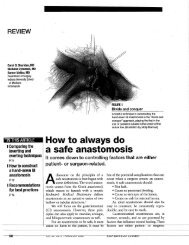SRPS PS - Plastic Surgery Internal
SRPS PS - Plastic Surgery Internal
SRPS PS - Plastic Surgery Internal
Create successful ePaper yourself
Turn your PDF publications into a flip-book with our unique Google optimized e-Paper software.
<strong>SR<strong>PS</strong></strong> Volume 10, Issue 25, 2009<br />
incidence of metastases. Treatment usually consists of<br />
surgery (often involving a partial amputation 313 ),<br />
radiotherapy, and chemotherapy.<br />
Fibrosarcomas—Fibrosarcomas arise within the<br />
deep subcutaneous space, fascial septa, or muscle and<br />
present as insidiously growing deep masses. 339,340<br />
Lymph node metastases are less common with<br />
fibrosarcoma, but hematogenous spread frequently<br />
occurs. Treatment is wide excision or amputation when<br />
neurovascular structures are compromised. 341 Adjuvant<br />
therapy can be of benefit.<br />
Clear cell sarcomas—Clear cell sarcomas<br />
(malignant melanomas of soft parts) are uncommon<br />
tumors. A clear cell sarcoma presents as a slowgrowing,<br />
deep-seated mass attached to tendons,<br />
aponeuroses, or fascia. 342,343 Prognosis is poor, with a<br />
very high rate of local recurrence and both lymphatic<br />
and hematogenous dissemination. <strong>Surgery</strong> with node<br />
dissection usually is combined with radiotherapy<br />
and chemotherapy.<br />
Kaposi sarcomas—Kaposi sarcomas are<br />
malignant tumors that often involve bone and can<br />
originate in bone. The hand and foot are the most<br />
common locations of occurrence and early<br />
detection. 344 Patients of all ages can be affected, from<br />
very small children to the elderly, with peaks in the<br />
4th and 5th decades. The male-to-female ratio is 10:1,<br />
and Kaposi sarcoma is strongly associated with<br />
acquired immunodeficiency syndrome. 345<br />
The first clinical signs are dark blue to violaceous<br />
macules on the skin that are later replaced by<br />
infiltrative plaques and finally by nodules measuring<br />
0.5 to 3 cm in diameter. Some of the lesions heal, and<br />
others coalesce and ulcerate. Initially, the skin lesions<br />
correspond to the distal end of the tumor in the bone,<br />
but in time, the skin manifestations appear at<br />
progressively more proximal levels. Radiographic<br />
examination reveals the affected bones to be<br />
decalcified in a trabecular pattern, with cortical<br />
thinning as the tumor expands. Cystic erosion shows<br />
as bites taken out of the bone.<br />
Treatment is by a combination of radiotherapy<br />
and chemotherapy. The prognosis varies according to<br />
the behavior of the tumor. Fulminating lesions have a<br />
fatal outcome within 6 to 12 months of diagnosis,<br />
20<br />
whereas slower growing tumors are compatible with<br />
20-year survival.<br />
Metastatic Tumors<br />
Hand metastases are very uncommon and usually are<br />
associated with a primary carcinoma in the lung 346–348 or<br />
kidney. Despite their rarity, metastatic tumors should be<br />
considered in the differential diagnosis of inflammatory<br />
processes of the hand. The distal phalanges are most<br />
often involved, and metastases in those locations often<br />
are mistaken for felons or paronychia. 349–351<br />
Amadio and Lombardi 352 recommend palliative<br />
treatment considering the median survival time of only<br />
5 months. Amputation of a phalanx, digit, or ray is<br />
recommended for most solitary phalangeal or<br />
metacarpal lesions when survival is expected to exceed<br />
a few months. 348<br />
SOFT-TISSUE RECONSTRUCTION<br />
Fingertips<br />
The treatment objectives of fingertip amputations are<br />
as follows:<br />
close the wound<br />
maximize sensory return<br />
preserve length<br />
maintain joint function<br />
obtain a satisfactory cosmetic appearance 353–356<br />
Many variables affect the reconstructive choice:<br />
mechanism of injury; size of defect; location and status<br />
of wound; associated injuries to other parts of hand;<br />
and age, sex, general health, and occupation of patient.<br />
Healing by Secondary Intention<br />
If the skin loss is no larger than approximately 1.5 cm 2 ,<br />
the wound can be allowed to granulate and heal<br />
spontaneously. 357–359 Such treatment is especially well<br />
suited to children and the elderly. All devitalized tissue<br />
should undergo débridement, and any exposed bone<br />
should be trimmed to lie below the level of the soft<br />
tissue. The wound is covered with a semi-occlusive 360<br />
or alginate dressing, which can be left intact for 5 to 7<br />
days and can then be changed as necessary. Complete<br />
healing usually is achieved in 3 to 4 weeks. Mennen<br />
and Wiese 360 treated extensive fingertip defects by<br />
using this method and reported excellent functional






